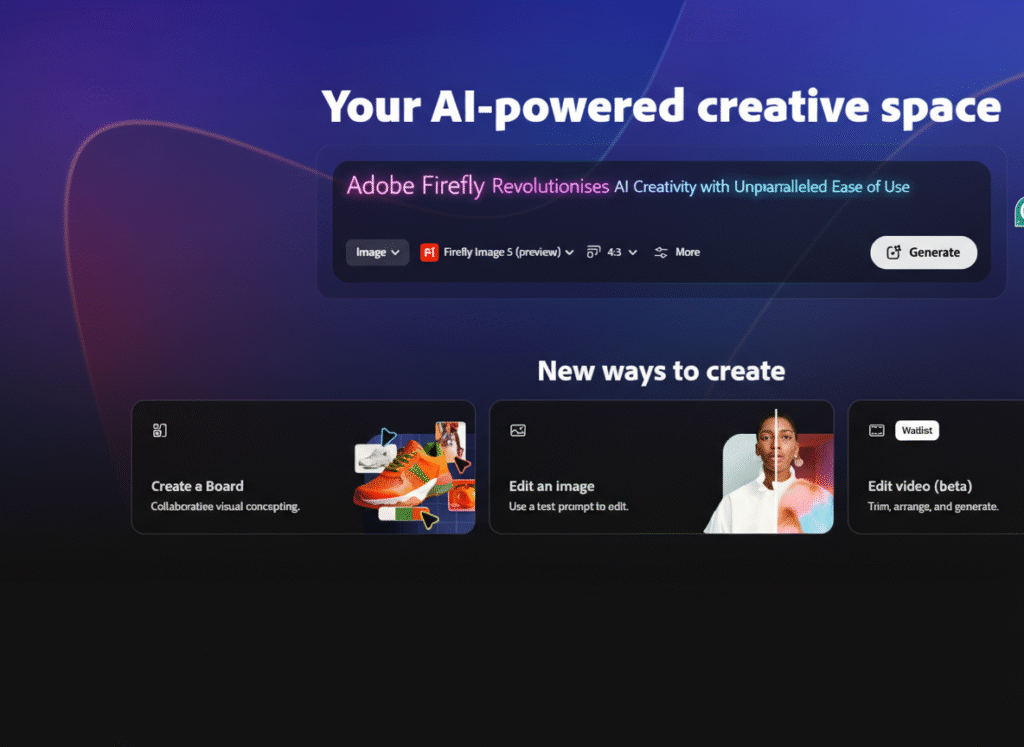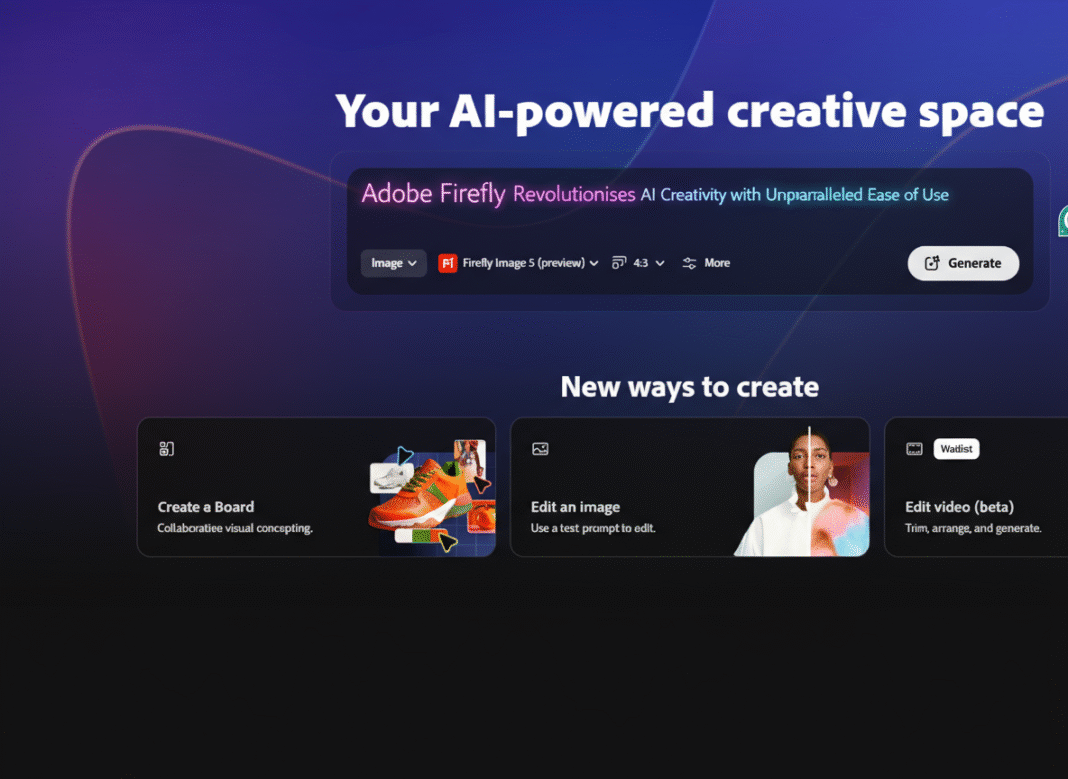In the growing world of generative artificial intelligence, where computers can already generate photographs, videos, texts, and designs with eye-popping realism and quickness, a subtle revolution is occurring in the creative fields. Adobe Firefly, Adobe’s lead generative AI model, is becoming a leader—not because it impresses with dreamlike artwork or news-generating gimmicks, but because it is trying to combine professional-level accuracy with record levels of user-friendliness. This balance is making Adobe Firefly the most user-friendly and reliable creative AI solution available in the market today, particularly for designers, marketers, content creators, and teachers.

In the growing world of generative artificial intelligence, where computers can already generate photographs, videos, texts, and designs with eye-popping realism and quickness, a subtle revolution is occurring in the creative fields. Adobe Firefly, Adobe’s lead generative AI model, is becoming a leader—not because it impresses with dreamlike artwork or news-generating gimmicks, but because it is trying to combine professional-level accuracy with record levels of user-friendliness. This balance is making Adobe Firefly the most user-friendly and reliable creative AI solution available in the market today, particularly for designers, marketers, content creators, and teachers.
The Adobe Firefly story is not merely what it can do—compute images based on text input, create stylised text effects, re-colour vectors, fill in image gaps, and assist with producing videos—but how naturally it does so. In an environment where competitors such as Midjourney, DALL·E, Canva’s AI platform, and Runway ML provide different types of generative powers, Firefly sets itself apart by not just prioritizing power but also workflow harmony, ease of use, ethical AI practices, and full integration into the tools creative professionals already use on a daily basis.
Beta-launched in 2023 and developing at lightning speed ever since, Adobe Firefly was created from the very beginning with one purpose: to accelerate creativity without disempowering the user. Most AI tools, though incredibly strong, also tend to have high learning curves, complex interfaces, or processes that live in bubbles—separate from the day-to-day platforms professionals work on. Adobe, with its four-decade history of design software, knew that if it was going to truly empower users, AI would need to be experienced as a collaborator, not a puzzle piece. That’s where Firefly excels so magnificently.
What drives Firefly’s magic is its complete and effortless integration into the Adobe Creative Cloud workflow. Photoshop, Illustrator, Adobe Express, and Premiere Pro users now have Firefly features built into their very workflows. Whether it’s a social media coordinator creating headline-grabbing typographic posters in Express, a YouTuber automatically expanding thumbnails in Photoshop, or a product designer applying generative recoloring to branding packaging in Illustrator, the use of AI is effortless and assistive. There’s no requirement for learning new interfaces or toggling between programs. This is in stark contrast to Midjourney, for instance, which asks users to create images through Discord commands—a model that, although cherished by digital artists and technical users, repels many newcomers and old-school professionals.
Midjourney does have some upsides. It has become the platform of choice for high-concept, highly stylised visual work. Its software can create images with depth textures, impossible lighting, and otherworldly beauty—outputs that are often breathtaking. But such images are hard to manipulate or customise for functional purposes such as logo creation, product labelling, or corporate identity. And since Midjourney has no native support for any mainstream design application, its users have to manually download and move their assets into other programs to modify them. This fragmentation restricts its usefulness for those who value speed, accuracy, and convenience over sheer aesthetic drama.
DALL·E, developed by OpenAI, fares better in the accessibility department. Available through a web interface and now integrated into ChatGPT for Plus users, DALL·E allows for image generation and inpainting, where users can edit or modify specific portions of an image. This makes it more flexible than Midjourney for iterative design. Yet, DALL·E works mostly in a vacuum of any particular creative suite, and its outputs, as commendable as they are, tend to be short of the design finish that Adobe Firefly provides. The products generated by Firefly are cleaner, more polished visually, and suitable for professional applications. Notably, it is also ethically sourced. Adobe trains Firefly’s models solely on Adobe Stock photos, openly licensed materials, and public domain images.
This emphasis on ethical AI deployment is a major distinguishing factor. While the controversy grows regarding AI-generated content ownership and licensing, Adobe has taken proactive action. It guarantees that all Firefly outputs are safe for commercial use. That guarantees peace of mind, particularly for businesses, marketing teams, and agencies that need to ensure that they are not violating any third-party copyright. Conversely, Midjourney and DALL·E continue to exist in somewhat of a grey area when it comes to dataset openness and copyright protection, causing concern for professionals seeking legal certainty.
Another significant player in the AI creativity field is Canva. Famous for its drag-and-drop interface, Canva has rolled out a variety of AI features—from text-to-image creation and AI writing assist tools (Magic Write) to background removal and layout recommendations. Canva’s AI is perfect for social media managers, small businesses, and students with limited design skills who require instant, stunning visuals. When it comes to usability, Canva could well compete with Adobe Firefly. Yet, it does not have the creative nuance, pixel-level detail, and high-fidelity output Adobe tools are capable of. Canva is perfect for creating social media flyers, posters for the classroom, or marketing cards. But when there is a need for high-resolution branding, in-depth infographic creation, or movie-quality video optimisation, Canva’s capabilities are outstripped.
Talking about video, that is where Runway ML is making its entry. This AI tool is making waves with its capacity to edit and create video content through machine learning. From green screen elimination and face tracking to text-to-video generation and motion retargeting, Runway ML has tools that are verifiably revolutionary. Yet its workflow and interface are better for users with technical knowledge. For most creators, especially those without prior video editing experience, the sophisticated features of Runway ML may be daunting or too complex. On the other hand, Adobe Premiere Pro users now get to tap into Firefly’s generative ability—such as suggested automated b-rolls or extension of scenes—directly within the same timeline and interface they are already familiar with.
So, what particularly makes Adobe Firefly so user-friendly compared to its competition? It’s not necessarily the features it provides—although they are myriad and expanding. It’s how carefully those features are wrapped. The Firefly web app, even still in standalone beta mode, welcomes users with a clean dashboard. You can select generating text effects, making vector recolours, or designing from prompts in seconds. For beginners, there are preset styles and templates. For professionals, there’s granular control over colour palettes, lighting, and composition. Adobe’s famed user-experience design principles shine through, making every action feel intuitive and empowering.
Even the way Firefly handles prompts is distinctive. Rather than requiring precise, often esoteric prompt phrasing like Midjourney or DALL·E, Firefly guides users through the process. Want a “vintage floral pattern in soft pastels”? Firefly understands. Need to stretch out the background of a product image to accommodate a new aspect ratio? Simply select the area and invoke. It’s these tiny usability victories that add up immensely in the long run—especially for customers who need instant results without wrestling with software sophistication.
The business ramifications of this ease of use are staggering. As companies compete to produce content at scale across channels—social media, print, digital ads, email campaigns—the capacity to create on-brand, editable assets quickly becomes a business advantage. Adobe Firefly isn’t simply making people more creative; it’s making businesses more efficient and consistent. Design teams are now able to prototype campaign concepts in hours, not days. Educators can now create visually appealing teaching aids without graphic designers. Content creators can quickly revise thumbnails, posters, and tales like never before.
In addition, Adobe’s accessibility commitment extends to dozens of languages, assistive capabilities for individuals with disabilities, and enterprise-friendly features that enable team collaboration and brand governance. Adobe also recently announced that custom model training will be available soon, so organisations can tailor Firefly to create content in their own brand voice or visual aesthetic.
All of these point to a future where creative AI becomes not just a novelty, but a standard part of everyday professional life. The tools will evolve, the features will expand, but the underlying principle will remain: creativity should not be limited by technical knowledge or software barriers. Adobe Firefly embodies that principle better than any other tool on the market right now.
Though the AI competition is far from finished, with developments still pouring in from every quarter, Firefly’s present status as the easiest to use and workflow-friendly tool that it is grants Adobe a considerable advantage. It recognizes the subtleties of design production, the significance of trust with commercial content, and the necessity of AI to be experienced as a partner instead of an impediment. As creatives worldwide struggle with the potential and pitfalls of generative AI, Firefly presents a reassuring vision: one in which technology unlocks human imagination, not replaces it.
And maybe that’s the real legacy Firefly is starting to create—not as an AI solution, but as a middleman between inspiration and realisation, between imagination and tech, and between concept and consequence. In that way, Firefly doesn’t simply make creating simpler. It makes it more human.
Discover more from Creative Brands
Subscribe to get the latest posts sent to your email.






